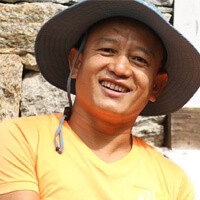Since 1995, Himalayan Ecological Trekking Pvt. Ltd. has been committed to offering memorable and safe trekking experiences in Nepal. As a responsible company, we believe in sustainable tourism blended with a sense of responsibility towards the society and environment. We equally focus on the betterment of people, communities, society, and the nation.
As part of our corporate social responsibility (CSR), Himalayan Ecological Trekking has been contributing to various sectors, such as education, health, and relief programs, particularly in rural areas of Nepal. Since our inception, we have worked to improve society through different initiatives. We allocate a portion of our earnings to CSR-related activities and contribute to projects that positively impact the lives of individuals and communities.
We have contributed to the establishment of schools in rural areas of the Upper Dhading and Dolakha districts of Nepal and helped with the supplementation of teachers in those schools. HET has also built schools in coordination with various individual trekking groups and donors.
Our company has sponsored orphanages for destitute children and health camps in rural regions of Nepal. While continually getting involved in social welfare projects, we also encourage and motivate our valued guests to contribute towards the conservation of nature and the welfare of needy people of Nepal.
Notable Projects for Society:
Education-Related Projects
First Project – Lamasthan Basic School, Jyamrung, Dhading (2009)
In 2009, we constructed a five-room primary school building in the underdeveloped rural village of Jyamrung, complete with necessary furniture such as benches, desks, and blackboards. With the help of Roman Mueller and his friends from Germany, we made this dream a reality. Later, we upgraded the school from primary to secondary level and committed to covering the salaries of three lower-secondary teachers for five years. Currently, Rupchandran Gurung and Bikesh Rana, the founding members of Himalayan Ecological Trekking, support the students by providing school bags in cooperation with Michal.|
Second Project – Jyoti Primary School, Jharlang, Dhading (2010)
In 2010, we constructed a five-room primary school in the rural village of Jharlang, Dhading. We also committed to paying the salary of one primary teacher for five years. Unfortunately, the school building was damaged by the earthquake in April 2015, but we rebuilt it as an earthquake-resistant structure with six rooms. This project has received support from Roman Mueller and Himalayan Ecological Trekking.
Third Project – Puru Primary School and Limju Primary School (2010)
In 2010, we constructed two additional five-room primary schools. We committed to covering the salaries of two primary teachers for five years. The 2015 earthquake destroyed both school buildings, but we rebuilt them as earthquake-resistant structures with six rooms.
Earthquake Relief Projects
As responsible citizens, we take pride in supporting our community, especially in times of crisis. After the devastating earthquake that hit Nepal on April 25, 2015, we knew we had to step up and help those in need.
The earthquake in April 2015 devastated many rural households, particularly in Gorkha, Dolakha, Dhading, Sindhupalchowk, and Kavre districts. Many families lost their homes, and some lost their lives. In response, Himalayan Ecological Trekking distributed tents, food, and tarpaulins to around 10,000 people in Dhading, Sindhupalchowk, and Kavre. Additionally, we supported temporary classrooms in Sindhupalchowk, Kavre, and Dhading by assisting two schools in Sindhupalchowk, three in Kavre, and three in Dhading.
During our travels across different parts of Nepal after the earthquake, we saw firsthand the destruction caused to homes, schools, temples, water tanks, and other infrastructure. The government was doing its best to assist the affected areas, but many villages were still struggling.
As a responsible business, we felt it was important to lend a hand where it was needed most. Our efforts focused on the Dhading and Sindhupalchowk districts, two of the worst-hit areas. In Dhading, we provided aid to several villages, including Fafal Chhap, Dwarthowk, Maidi, Sunaula Bazar, and Sang Kush Village. In Sindhupalchowk, we also reached out to communities in need.
We worked hard to help these people rebuild their lives. Our support included providing basic necessities like food (rice, dal, snacks) and building shelters for families who had lost their homes. We also worked on restoring vital infrastructure to help communities recover and get back on their feet.
Our goal was not only to provide immediate relief but to help these communities rebuild in the long term. We are proud of the efforts made, and we continue to support these areas as part of our commitment to making a positive impact in Nepal.
Dhading District
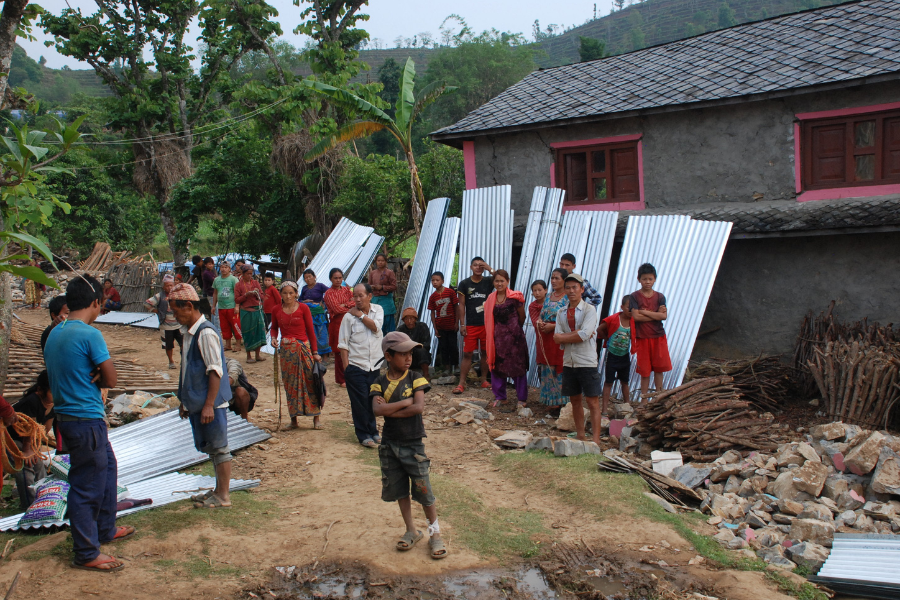
In Dhading, we worked tirelessly to support the villages affected by the earthquake. One of our
key contribution was the donation of 127 bundles of Jastapata, a type of Steel used in roofing
materials, which are highly valued for their durability and ability to withstand harsh weather
conditions. The Jastapata was donated to both schools and affected households to help rebuild
their homes and restore educational facilities that were destroyed in the earthquake.
In addition to the Jastapata donation, we provided tarp shelters (Paal) to the people in need.
These temporary shelters helped families create safe spaces to live while they rebuilt their
homes.
We also distributed food supplies such as rice, dal, and snacks, ensuring that the affected
families had enough to sustain themselves during the recovery period.
To further support their immediate needs, we provided basic useful items, including:
∙Soap and detergent powder for cleaning clothes and maintaining hygiene, which was
especially crucial in the aftermath of the disaster.
Water purifying liquid to make local water sources drinkable, reducing the risk of
waterborne diseases, which are common in post-disaster situations.
These efforts were aimed at ensuring that the communities had not only the essentials to survive
but also the tools to begin rebuilding their lives with dignity and safety.
Sangkosh Village
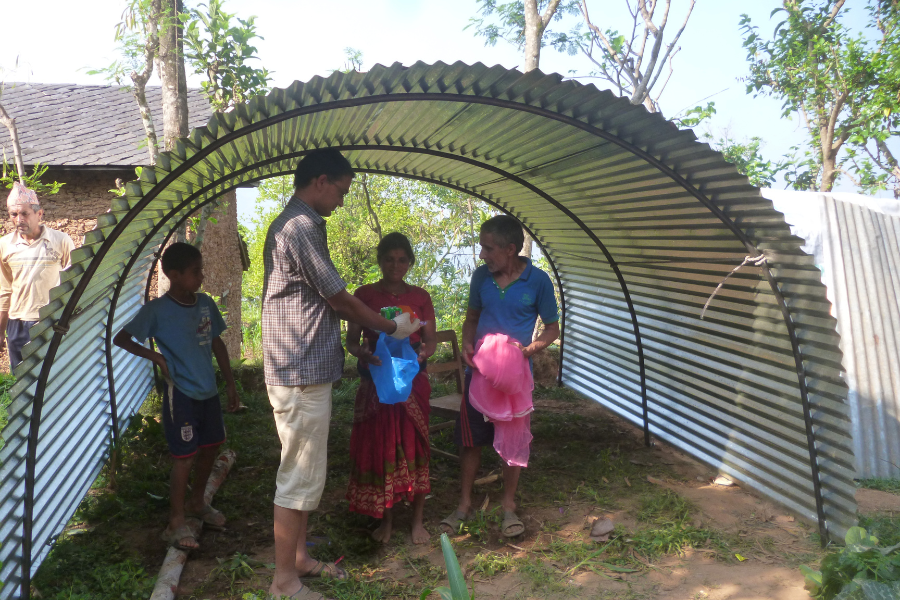
In Sangkosh Village, we focused on providing aid to a particularly vulnerable group: widows
who had lost their homes and family members in the earthquake. We donated 11 bundles of
Jastapata helped build shelters specifically for these widows, giving them a place to live while
they navigated the difficult journey of recovery. The Jastapata provided a strong, reliable roofing
material for these shelters, ensuring that they were protected from the elements.
This support was vital in helping widows regain a sense of security and stability after losing
everything. By providing them with the means to rebuild, we hoped to ease their burden and
support them as they worked to recover and move forward with their lives.
Kafal Chhap Village
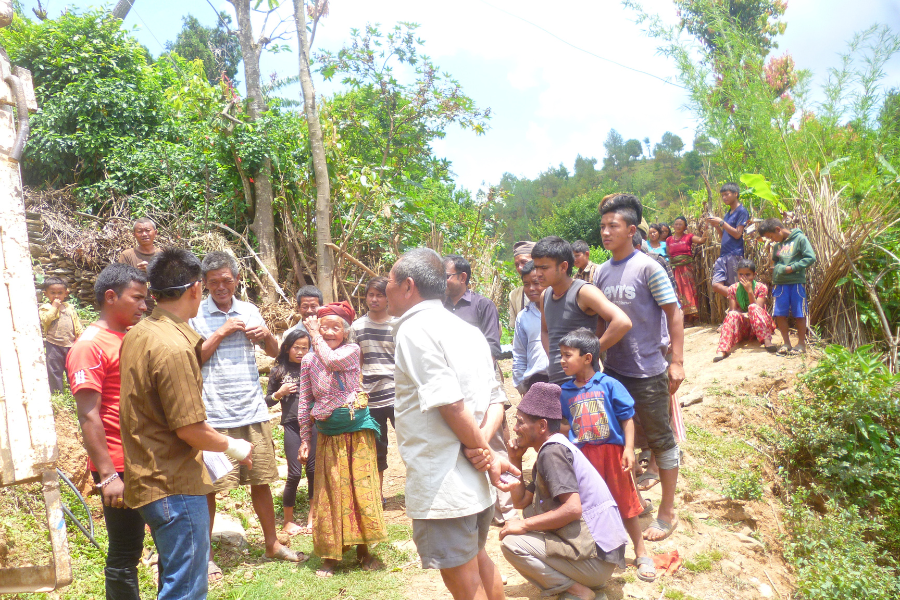
This village suffered extensive damage, with many houses destroyed. We helped by providing emergency food supplies, including rice (Chamal), dal, and
snacks, as well as building temporary shelters for families who had lost their homes.
Dwarthowk Village
In Dwarthowk, the infrastructure was severely impacted, including water
tanks that supplied the village with clean water. Our team worked on rebuilding damaged water
tanks and providing necessities like food and shelter.
Maidi Village
Maidi was another area that faced great hardship after the earthquake. We
worked to provide essential food items, as well as building safe, temporary shelters for the
displaced villagers. In addition, we contributed to restoring local schools and community centers.
Sunaula Bazar
This area was hit hard by the earthquake, and many families lost their homes
and businesses.
In Sunaula Bazar, we focused on providing food aid and rebuilding homes. We
also assisted in restoring some of the small businesses that were essential for the local economy.
To assist an additional 97 households across the villages, we donated 97 bundles of Jastapata,
along with rice (chamal), dal, and other food supplies. These donations helped provide shelter
materials and sustenance for families who had lost their homes and livelihoods, ensuring they
had the resources to start rebuilding their lives.
Educational Support
The earthquake had a profound impact on the education system in Nepal, with many schools
completely destroyed or severely damaged. In many areas, children found themselves unable to
continue their studies due to the collapse of school buildings and the loss of educational
materials.
Recognizing the critical need for educational support during such a time, Bikesh
Rana, our co-founder and managing director, took a hands-on approach to ensure that affected
schools received the aid they needed to reopen and continue their operations. Bikesh, along with
his dedicated team travelled to these schools and coordinated relief efforts directly, making sure
that each school received the support it required.
Here are some of the key contributions made to schools in the affected regions:
1. Kafalchhap Primary School
This school was heavily impacted by the earthquake, with many of its buildings suffering severe damage. To help the school get back on its
feet, we donated 19 bundles of Jastapata, which were used to rebuild the roofs of classrooms and other essential facilities. Jastapata is a durable local material used for roofing and is vital for rebuilding structures that can withstand harsh weather conditions.
2. Bhairavi Secondary School
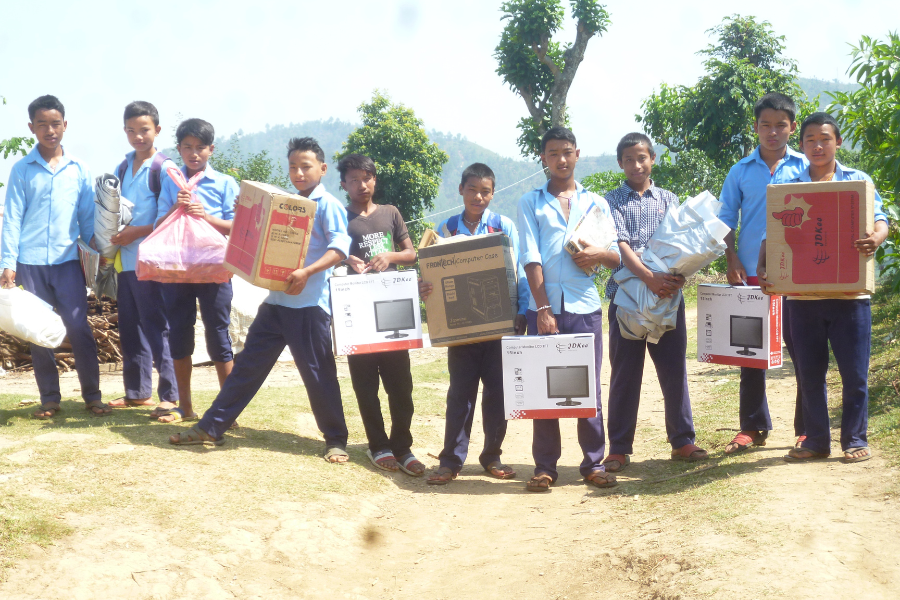
Bhairavi Secondary School faced extensive damage to its
infrastructure, including the loss of essential teaching materials. In response, we donated
three sets of computers, along with Paal (tarp shelters) and Jastapata to help restore
classrooms and other learning spaces. The computer sets were particularly valuable in
helping students continue their digital learning, as the earthquake had disrupted access to
modern educational tools. The tarp shelters provided temporary classroom spaces,
allowing education to continue while permanent repairs were made to the buildings.
3. Shree Nawalpur Primary School
Shree Nawalpur was another school that faced
extensive damage due to the earthquake. We contributed by donating one set of
computers, which helped the school re-establish its digital learning capacity. In addition
to the computers, we worked on renovating the school grounds, ensuring that students
had a safe place to study and learn. Temporary classrooms were built with the help of
Jastapata and tarp shelters, ensuring that the students could continue their education
without significant interruption.
4. Newarpane Primary School
Newarpane Primary School also suffered substantial
damage after the earthquake. To assist in the school’s recovery, we donated one set of
computers, enabling the school to continue its digital learning programs. In addition, we
contributed to building a water supply system to ensure that students and staff had access
to clean, safe water. This was especially important in the aftermath of the earthquake, as
access to clean water became a critical issue for many communities. We also helped
renovate the school, making the necessary repairs to the infrastructure to provide a safer,
more stable environment for the students.
The earthquake not only destroyed buildings but also disrupted the educational future of
thousands of children. Schools were used as emergency shelters, and many were left in ruins. In
response, our team worked tirelessly to ensure that children could return to their studies as soon
as possible. The donations of materials like Jastapata, computers, and shelters were key to
helping these schools continue functioning, providing students with the opportunity to regain a
sense of normalcy during an incredibly difficult time.
5. Nawalpur Primary School – Rebuilding the Saraswati Temple
One of the significant cultural and spiritual landmarks at Shree Nawalpur Primary School was
the Saraswati Temple, a vital part of the community’s heritage. The temple, dedicated to
Saraswati, the goddess of knowledge and learning, was destroyed during the earthquake, leaving
a void in the community’s spiritual and educational life.
Understanding the deep cultural importance of the temple, Bikesh Rana and the Himalayan
The ecological Trekking team decided to take action. We spearheaded the reconstruction of the
Saraswati Temple, ensuring that this sacred space would be restored for the students and the
broader community. The temple not only holds cultural significance but also serves as a place of
inspiration and prayer for students and teachers alike, reinforcing the value of knowledge and
education.
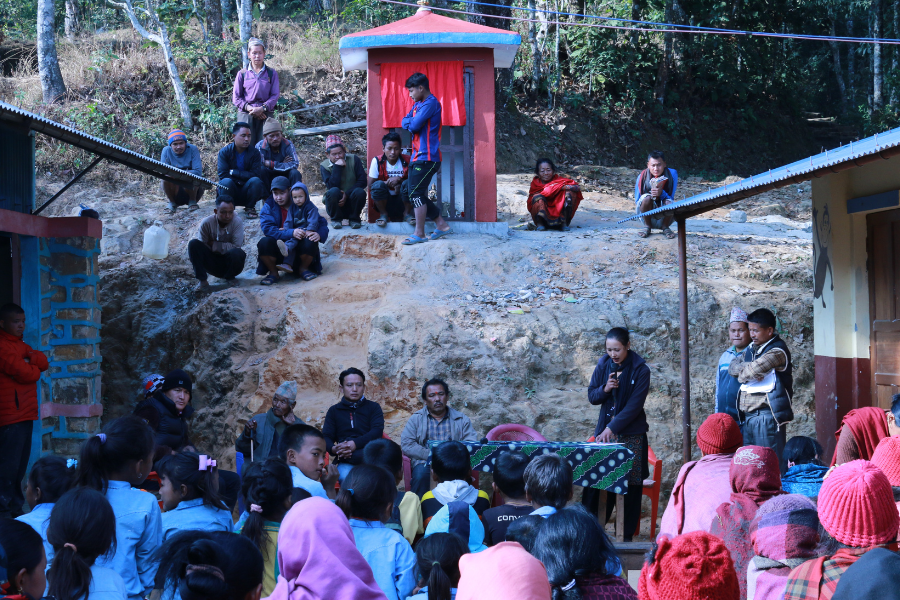
The reconstruction of the Saraswati Temple was carried out with care and respect for its spiritual
importance. Local materials, including Jastapata, were used in the rebuilding process to ensure
durability and authenticity. The completed temple now stands as a symbol of resilience, faith,
and the community’s commitment to rebuilding their lives after the disaster. It serves as a place
where students, teachers, and residents can come together to pray and reflect, fostering a
sense of unity and hope in the face of adversity.
Health-related Projects
The 2015 earthquake not only caused immense damage to homes and schools but also severely
affected essential healthcare infrastructure. Many health posts and medical facilities were either
destroyed or rendered inoperable, putting vulnerable communities at even greater risk. In
response, Himalayan Ecological Trekking recognized the critical need to restore healthcare
services and ensure that local populations had access to basic medical care.
One of our key health-related projects was the renovation of the Health Post in Sunaulabazar,
Dhading. This health post served as a crucial medical centre for thousands of people, and after
the earthquake, it was left severely damaged and unable to serve the community effectively. To
address this urgent need, we stepped in with the following support:
Health Post Renovation:
We took on the task of renovating the Sunaulabazar Health
Post, repairing structural damage and restoring its ability to provide essential healthcare
services to the local population. This renovation included repairing walls, ceilings, and
Windows, as well as ensuring that the building was made safe and functional for medical
staff and patients.
Provision of Medical Supplies: In addition to the renovation, we also worked to supply
the Health Post with essential medical equipment and supplies that were lost or damaged
during the earthquake. This included basic healthcare supplies such as medicines,
bandages, medical instruments, and sterilization tools to support the medical team in
providing treatment.
Improving Health Services Access: With the restoration of the Health Post, the
community regained access to vital services such as maternal healthcare, vaccinations,
and emergency medical treatment. This renovation was essential in ensuring that people,
particularly those in rural areas who had access to basic health services during the long
recovery period following the earthquake.
The renovation of the Sunaulabazar Health Post was a critical step in restoring not just the
physical infrastructure, but also the health and well-being of the people in the surrounding areas.
It ensured that they could receive necessary medical attention without having to travel long
distances to larger hospitals, which were already overwhelmed with patients.
Health Camp 2020, Semjong, Dhading
From February 23-24, 2020, we sponsored FDM Training for Nepalese doctors at Nepal National Hospital in Kalanki, Kathmandu. From February 24-26, 2020, we conducted a free health camp for orthopedic patients in the rural village of Dabjong Netrawoti. This program, supported by Dr. Karsten Wichmen and a team from Germany, was organized in collaboration with the Jyamrung Welfare Committee, Dabjong Netrawoti Rural Village, and Nepal National Hospital.
The first three days of the program involved theoretical and practical training on the Fascial Distortion Model (FDM) and the Typaldos method, based on the curriculum of EFDMA (www.fdm-europe.com). On the final day, all health workers participated in the health camp. The program benefited around 156 patients, none of whom had serious health issues.
We owe the success of this health camp to social workers Rupchandra Gurung, Bikesh Rana, and the entire Himalayan Ecological Trekking team, as well as Krishna Man Shrestha, the JWFC team, the doctor team from Kathmandu National Hospital, and the Health Post team of the local area.
Drinking Water Project
In the aftermath of the earthquake, the destruction of local infrastructure, including drinking
water supplies posed a significant challenge for affected communities. Access to clean and safe
drinking water became a pressing concern, particularly in rural areas where existing water tanks
and supply lines were either damaged or destroyed. Recognizing the urgency of this issue, Himalayan Ecological Trekking made it a priority to help rebuild the water supply
systems in these communities, ensuring that families had access to clean water for drinking,
cooking, and daily needs.
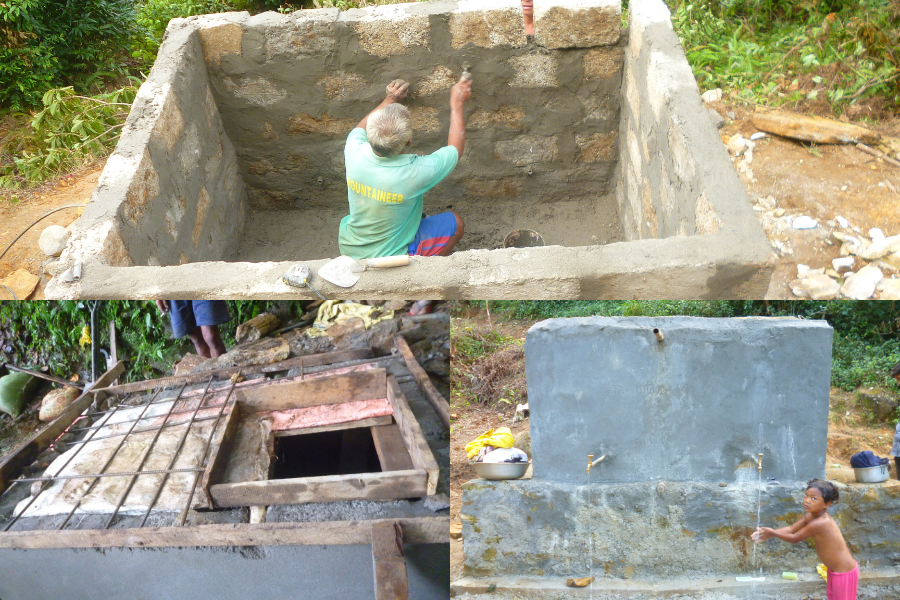
Our Drinking Water Project focused on rebuilding water storage tanks and providing essential
water supply lines to communities in Dwarthok-Maidi Village and Nawalpur, both in Dhading.
Here's how we contributed to this vital effort:
1. Rebuilding Drinking Water Tanks:
The water tanks in these villages were severely
damaged or destroyed during the earthquake, leaving the community without a reliable
source of clean water. We worked to rebuild drinking water tanks in both Dwarthok-
Maidi Village and Nawalpur, ensuring that the communities had secure, sustainable
access to water. These new water tanks were designed to withstand future environmental
challenges, providing long-term solutions to water storage needs.
2. Providing Water Supply Line Pipes:
In addition to rebuilding the water tanks, we also
installed water supply line pipes to connect the newly constructed tanks to the
surrounding homes and community areas. The water supply lines ensured that clean
water could be efficiently distributed to each household, eliminating the need for people
to travel long distances to access water, which was especially difficult for families in
rural areas.
3. Improving Access to Clean Water:
With the reconstruction of the drinking water tanks
and the installation of water supply lines, the communities in Dwarthok-Maidi Village
and Nawalpur regained access to safe and clean drinking water. This not only improved
their daily living conditions but also helped prevent the spread of waterborne diseases,
which are common in areas with limited access to clean water.
Access to clean water is one of the most basic human needs and the earthquake’s destruction of
water systems exacerbated the challenges faced by many rural communities. By rebuilding these
essential water infrastructure projects, we helped restore a crucial lifeline to the people in these
villages, enabling them to focus on rebuilding their lives without the constant struggle to secure
clean water.
Sindhupalchowk District –
Affected by the Second Earthquake Sindhupalchowk district, located northeast of Kathmandu, was one of the areas most severely impacted by the earthquake that struck Nepal on April 25, 2015. This district was not only devastated by the first earthquake but also suffered even greater damage when a second powerful earthquake hit on May 12, 2015 (Baisakh 29 in the Nepali calendar). The second earthquake, measuring 7.3 magnitude, struck just weeks after the first one, adding to the already overwhelming destruction.
While the first earthquake had caused widespread damage, this aftershock exacerbated the situation, further collapsing already weakened structures, and destroying homes, schools, and critical infrastructure. Many of the buildings that had been temporarily patched up after the first earthquake were destroyed, leaving people even more vulnerable.
In Sindhupalchowk, where the earthquake's epicenter was located, the destruction was particularly severe. Many communities lost their homes and access to basic facilities like schools, water, and healthcare. The earthquake severely impacted daily life, as people were left without safe shelter and with limited access to the essentials needed for survival.
Our Relief Efforts in Sindhupalchowk
Recognizing the gravity of the situation and the need for continued support in Sindhupalchowk,
Himalayan Ecological Trekking Pvt. Ltd. mobilized its team to provide aid to the affected
communities, focusing on both emergency relief and long-term recovery. One of the key areas
we focused on was Shree Singarche Primary School, where we provided vital support to both
the school and the surrounding community.
Donation of Jastapata for Cottage Construction: In Shree Singarche Primary
.jpg)
Many of the classrooms and structures had been destroyed, leaving children
without a safe place to learn. To help rebuild the school and provide shelter for the local
community, we donated Jastapata, a local material used for roofing, which was essential
in constructing temporary cottages. These cottages served as temporary classrooms for
the students, as well as shelters for displaced families who had lost their homes during
the earthquake.
Providing Water Supply and Purification Systems:
Access to clean drinking water became a critical concern after the earthquake, especially since many water sources and tanks had been damaged or contaminated. To address this issue, we provided a water tank for the community, ensuring that people had a reliable source of water for drinking,
cooking, and other basic needs. In addition, we supplied a water purifier to ensure that
the water being collected was safe to drink, preventing the spread of waterborne diseases,
which are a common problem in post-disaster situations.
Building a Cottage for Students:
With many of the school’s original buildings damaged,
we also helped construct a temporary cottage for the students to continue their education.
The cottage was built with the help of Jastapata and other locally available materials,
providing a safe and stable learning environment for the children while the school
worked towards permanent rebuilding.
The Impact of the Second Earthquake
The second earthquake on May 12, 2015, was particularly devastating because it followed so
closely after the first. This left many families, especially those in rural areas like
Sindhupalchowk, feeling even more hopeless. The aftershock caused landslides that blocked
roads, making it difficult for aid to reach the most affected areas. The people of Sindhupalchowk
had already experienced trauma from the first earthquake, and the second tremor added to their
suffering. Despite the challenges, the resilience of the local people was remarkable.
Our support in Shree Singarche Primary School and surrounding villages was just one example of how we worked alongside the community to rebuild after this devastating second earthquake. The assistance provided helped restore basic services and gave people hope for the future,
despite the continued challenges they faced.
Current Projects
Currently, we are supporting Lamasthan Basic School, and Kamaladevi Basic School by providing school uniforms to all students.
However, our commitment to society does not stop here. We will continue striving to improve the lives of individuals, communities, and society as a whole. We look forward to launching new projects and collaborating with various partners to ensure their success.
We make our travellers aware of the essence of nature preservation in its most pristine form while taking pleasure in admiring its beauty. We also encourage our guests to contribute to the conservation of nature, biodiversity, cultural heritages, and the upliftment of people living in the backward regions of Nepal.
Ongoing Commitment
Our commitment to supporting the communities of Nepal extends far beyond the immediate aftermath of the 2015 earthquakes. Under the guidance of our Co-Founder and Managing Director, Bikesh Rana, we have not only focused on providing essential relief such as rebuilding schools, healthcare facilities, and infrastructure but also on fostering sustainable development and long-term recovery. Whether it’s through rebuilding homes and water systems, supporting education, or restoring healthcare access, we continue to work hand in hand with local communities to ensure their resilience and future well-being.
Our efforts aim to restore dignity and create opportunities for the people of Dhading, Sindhupalchowk, and other affected regions, empowering them to rebuild their lives and thrive for years to come. As we move forward, we remain steadfast in our dedication to creating lasting, positive change in these communities, strengthening not just physical infrastructure but
also the spirit of unity and hope that defines Nepal.
Let’s unite to strengthen the power of love and humanity, helping others as we move toward success!
.png)
